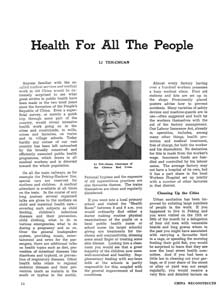Anyone familiar with the so-called medical services and medical work in old China would be extremely surprised to see what great strides in public health have been made in the two brief years since the formation of the People's Republic of China. Even a superficial survey, or merely a quick trip through some part of the country, would reveal intensive health work going on in the cities and countryside, in mills, mines and factories, on trains and in village schools. Today hardly any corner of our vast country has been left untouched by the broadly conceived and efficiently executed public health programme, which draws in all medical workers and is directed toward the whole population.
On all the main railways, as for example the Peking-Hankow line, special cars are reserved for mothers and children. A medical attendant is available at all times on the train. In the course of any long journey several organized talks are given to the mothers on child and maternal health care - covering such subjects as child feeding, children's infectious diseases and their prevention, child clothing, what to do in various emergencies, what to do during a pregnancy and so on. Over the general loudspeaker system, providing music, entertainment and news for the passengers, there are additional talks on health topics such as diet, prevention of intestinal diseases like diarrhoea and typhoid, or prevention of respiratory diseases. Other health talks relate to regional endemic diseases and their prevention (such as malaria in the south or typhus in the north). Personal hygiene and the exposure of old superstitious practices are also favourite themes. The trains themselves are clean and regularly disinfected.
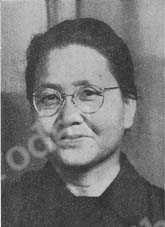
Li Teh-chuan, Chairman of the Chinese Red Cross.
If you went into a local primary school and visited the "Health Room" between 8 and 9 a.m. you would ordinarily find either a doctor making routine physical examinations of the pupils or a local public health nurse or school nurse (in larger schools) giving eye treatments for trachoma and conjunctivitis, dressing some small finger or treating some skin disease. Looking into a classroom you would see that a great majority of the children now seem well-nourished and healthy. Supplementary feeding with soy-bean milk at the schools is partly responsible for this, coupled with the general improvement of food conditions.
Almost every factory having over a hundred workers possesses a busy medical clinic. First aid stations and kits are set up in the shops. Prominently placed posters advise how to prevent accidents. Many varieties of safety devices and machine-guards are in use - often suggested and built by the workers themselves with the aid of the factory management. Our Labour Insurance Act, already in operation, includes, among many other things, health protection and medical treatment, free of charge, for both the worker and his dependents. No deduction for this is made from the worker's wage. Insurance funds are handled and controlled by his labour union. The average factory may not have a hospital of its own, but it has a part share in the local Workers Hospital set up jointly with a number of other factories in that district.
Cleaning Up the Cities
Urban sanitation has been improved by enlisting large numbers of people in the work. If you happened to live in Peking and you were visited on the 15th or 30th of the month by a delegation of four old men with venerable beards and long gowns whom in the past you might have associated with carrying a favourite bird in a cage, or spending the morning feeding their gold fish, you would be surprised to learn that they are now the local street health committee. And if you had been a little lax in cleaning out your garbage, or if your share of the street or alley or yard was not swept regularly, you would receive a very firm and detailed lecture on sanitation and a request for improvement before their next regular visit.
Incidentally, Peking at the time of liberation had 201,638 tons of garbage and refuse piled up in the city, which took the efforts of 73,537 volunteers and sanitary workers, using 35,407 carts and over 800 trucks, to clean up. At Tangshan, in Hopei province, exposed garbage and refuse dating from twenty years back has been successfully removed. Well-functioning garbage disposal systems now operate in these two cities and scores of others which never had them before.
In nearly all the major cities of China sewers are being cleaned out and repaired. Water pipes are being laid to bring fresh, clean piped water to workers homes and districts.
In Peking, for example, the infamous "Dragon Beard Ditch" once wound its filthy way for several miles behind the famous Temple of Heaven, through a quarter where only working people lived. It was a public health menace of the first order. Dating back 300 years, it was stagnant, filled with garbage, rotting matter, dead dogs, dead cats and worms. In summer it was a breeding place for flies and mosquitoes and was responsible, in large measure, for many of the epidemics that raged among the 400,000 people that it "serviced." Under the old regime nothing was done about this. The People's Government, in five months from May to September 1950, eliminated the ditch and laid five miles of concrete conduits instead. Piped water was brought into the area for the first time. An old man living on the bank of the ditch said afterwards: "I have been here for 72 years but this is the first year I have lived in a clean place, with no flies, mosquitoes or worms to bother me."
Other Urban Services
The tremendous amount of public health work going on in our cities cannot even be outlined in a short article. There is now a vast network of creches and nurseries caring for more children, and caring for them better, than ever before. Countless mothers are active in the peace campaign as the most concrete expression of child protection; because both mothers and medical workers realize that no matter how healthy a child is, or anyone else for that matter, there can be no safety of life or limb unless war is prevented.

Housewives turn out to clean a Peking street. Dirt and garbage have disappeared from public thoroughfares since householders were organized for regular clean-ups of this kind.
Other health changes in the cities include physical culture activities on an unprecedented mass scale; special measures for the protection of women in industry; the increase and expansion of hospitals, clinics and dispensaries; institution of isolation hospitals and public health laboratories; establishment of chemical and medical equipment factories and a greater number of medical universities and colleges. These vast developments cannot even be treated in the present article.
Fighting Rural Epidemics
But 80 per cent of China's population is rural. What about the countryside? What public health and medical work is going on in the hsien (counties) and farm villages?
Let us visit a hsien in what was previously a plague epidemic region in northeast China. In the county-seat there is the county public health department with three major sections under it - epidemic prevention and sanitation, protection of mother and child health, and medical administration. In this particular hsien, in addition to sanitation, public clinics and permanent work along preventive lines against smallpox and measles, the main task is the prevention of plague. Throughout the county there are plague prevention stations where a constant watch is kept for any signs of infection in humans, rats or fleas. Posters, lectures and plays for the population in this area center on plague. Around each village there is a newly-dug circular ditch with sharp, steep-cut sides. Patrolling the ditch are members of the Young Pioneers organization with red kerchiefs and long red-tasseled spears. They are on the lookout for rats in the ditch, which serves to prevent rats from coming into the village or escaping from it. Often one may see the children spearing a rat.
Although in the past 3,000 cases of plague might occur in a single year, there were only a few sporadic cases and no epidemics from 1950 on. The mobilized people in the endemic regions caught and killed 20,916,389 rats in 1950 alone, by an actual count of rat tails turned in to stations in northeast China. In addition to rat eradication and house-to-house sanitation, 5,933,700 inoculations against plague were given in 1950.
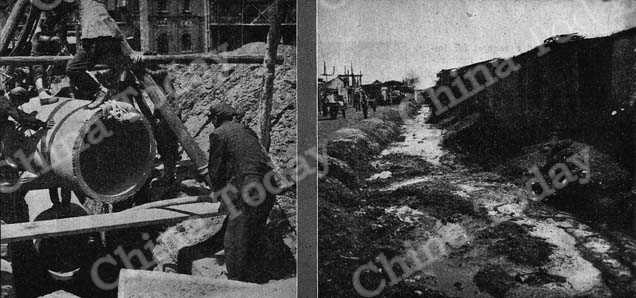
New culverts and sewer pipes (left) are replacing filthy open ditches (right) in the workers' districts of Chinese cities.
In Shantung province in East China, county health services are organized along the same lines, but here the main task is centered around the kala-azar eradication campaign. Shantung now has many kala-azar treatment stations and several mobile teams with doctors, laboratory equipment and trained injectors. In heavily infested regions prevention teams work on control of the sand-fly. Treatment is free of charge and, according to incomplete statistics, more than 60,000 cases of kala-azar were treated in 1950. Even so, the battle against this disease is only beginning.
Further south, in Kiangsu and Chekiang provinces, district health departments fight against schistosomiasis, which has the snail as its intermediary host and reservoir of infection. Methods are being worked out to control and eradicate these snails, which unfortunately are not as susceptible to copper sulfate as is the Egyptian variety, which transmits schistosomiasis in that country. Control of faeces (a source of infection) is being carried on with cooperation from the mobilized peasantry.
The peasantry, after having had explained to them the danger from raw human faeces being used as fertilizer and in this way transmitting the disease, have organized a "three tank system" for treating them. Only faeces that have been stored for a month or more (and thus made harmless from the point of view of schistosomiasis transmission) are used in the fields. The peasants and the whole population are now well aware of the danger from snails and there are constant snail-picking campaigns during the winter slack season. In winter the snails climb up on the banks of the streams and rivers. They are picked up with bamboo forceps. A recent champion snail picker collected 400 in a single hour. Eradication of snails would wipe out the disease. Suggested new methods to do this in a quicker and less laborious manner are now under study.
Along the Kiangsu-Chekiang provincial border in 1950, more than 30,000 cases were treated involving more than a half-million intravenous injections and 444,459 stool examinations. All medicines used in the treatment are now manufactured in China whereas previously there was complete dependence on imported drugs, even for the few cases treated. The cost was prohibitive, and those most in need of treatment could least afford it. Now all treatment is free of charge.
Health on National Construction Projects
In some hsien, health protecttion of the peasants working on water conservancy is the main concern. This is true along the Huai river, the middle course of the Yangtze and Han rivers, the middle and lower reaches of the Yellow River, the Pearl River and waterways in North China. In the spring and early summer of 1951, nearly 5,000,000 peasants were at work on water conservancy and flood control projects. The health protection of these workers is of prime importance for the completion of the urgent tasks of raising production and preventing floods. The Ministry of Health and other Area and Provincial Health departments have organized Epidemic Prevention Corps to supplement the efforts of the hsien health departments in this respect. There are 88 such corps throughout the country and a large number are assigned to this work.
What has already been accomplished by these epidemic prevention corps? The following are some sample answers.
A detachment of the Third Epidemic Prevention Corps provided health protection for 340,000 peasants of 10 hsien working on flood control. A total of 169,440 smallpox vaccinations were administered. Complete delousing was carried out and 1,236 cases of relapsing fever were treated, with the result that the spread of this disease was stopped. Latrines and faeces-disposal were organized. Water purification by chemicals was carried out on all work sites. Regular talks on hygiene were given to the workers.
When the flood control job was completed ahead of time, the team divided into two sections - one for kala-azar work, one for mother and child health training. The kala-azar section operating in nine hsien of the Huaiyin region treated 9,669 cases, trained 464 injectors locally, mobilized local medical personnel and, together with the county medical department, set up a permanent apparatus to clean out kala-azar from the region. The mother and child health section organized a three-month course in midwifery and child care for women cadres from the hsien women's organizations and other women workers, training 243 persons. In addition 69 old-style midwives were re-trained. Since the area in which both sections were operating was also a typhoid endemic region, hygienic measures were instituted and special areas for using river water to wash vegetables and clothes organized. The teams gave typhoid-cholera inoculations to 58,807 people, cleaned and purified wells and built new sanitary privies.
Nurseries were organized in the rural areas of central Hopei province in the busy June-July agricultural season. In Tali village, for example, a seasonal temporary nursery was set up on the basis of mutual exchange of labour. Four women, one of whom is a public health worker, are in charge of 51 children, in exchange for which their farm work is done by the women whose children they are minding. The mothers also prepare midday meals for the nursery-workers' husbands. The nursery is housed in the Yuehwang Temple which also houses the primary school. This method of seasonal nurseries was adopted from the Soviet Union and is proving a great success.
Rural Medical Cooperatives
Many rural areas now have self-supporting medical cooperatives. This is an extremely important development. I would like to describe a typical and successful example which serves Hsuwu and Taiwang, in Pingyuan province in North China.
When this area was liberated in 1948, medical attention was confined to the well-to-do and drugs were available only at two old-style Chinese pharmacies, which sold them at prohibitively high prices. In February 1949, the local People's Government and its medical department called a meeting, attended by fourteen doctors, to consider how to improve the situation. The proposal to form a medical cooperative was made and, after thorough discussion, adopted. Sixty shares were issued and distributed among a total of 31 doctors, both Chinese-style and modern, who paid for them in services, millet, equipment or medicines. A modern-trained doctor was named to head the medical staff of six and two clerks were hired. The co-op clinic began work in premises donated free of charge by the local government.
Peasants began to flock to the cooperative at once. They were given medicines and treatment on credit (it is the local custom to pay all bills after the harvest.) As a result, both supplies and funds were quickly exhausted. A crisis meeting was urgently called, and decided to issue more shares to be sold to peasants as well as doctors. These shares were quickly bought up by the eleven surrounding villages. Treatment was still available to everyone, but member-patients received a 10 per cent discount. There were no profits the first year but, as a result of the co-op's operations, the local price of medicines dropped 50 per cent.
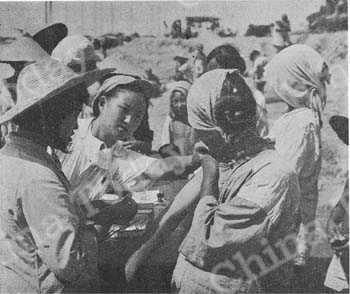
Vaccination against smallpox in the rural areas.
The co-op has since expanded greatly. In addition to giving ambulatory treatment and dispensing medicines, it now buys up locally grown medicinal herbs and sells them to other regions. This provides additional earnings for many peasants as well as for the cooperative itself. With the extra income, new services have been started: free treatment for families of People's Liberation Army soldiers, free smallpox vaccinations, health education and anti-epidemic campaigns undertaken jointly with the county health department. The cooperative is now a going concern and the pride of the Taiwang and Hsuwu peasantry, who regard it as their own.
Rural health cooperatives are spreading. Numbers of them already exist even in such formerly backward provinces as Jehol.
Citizens' Voluntary Health Work
In addition to the work of county health departments, epidemic prevention corps and medical cooperatives, great masses of people participate in public health activity through the Chinese Red Cross, the local Joint Medical Associations, labour unions, women's, youth and peasant associations and educational circles. A few instances will be enough to show the nature and scope of such voluntary action, the change in the people themselves and the great reserves of popular energy available in our new China.
In Linhsien, Pingyuan province, the county Joint Medical Association is now headed by Ko Hsu-hsien, an old-style Chinese doctor 62 years of age. Dr. Ko is a fervent advocate of preventive medicine and has been able to pass on his enthusiasm to others. He has mobilized over eighty doctors in his area into six groups which supplement the work of the County Health Department in no less than 52 villages. These volunteer medical men have in turn organized 1,074 village block health committees (each covering an area inhabited by ten families). The committees are active in public health propaganda, sanitary inspection, getting people to be vaccinated, reporting the occurrence of disease and registering births and deaths. Not a single one of these services existed in the countryside under the old regime, or indeed at any time in China's past history. Nor could they have begun now if we did not have a government based on the people.
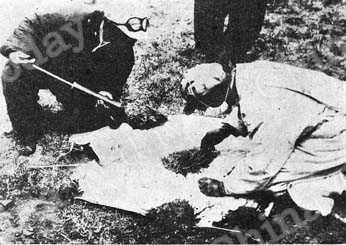
Anti-epidemic team exterminating fleas in Chapei, Shanghai.
In Linhsien, too, Dr. Ko organized, on his own initiative, what is known as the "Three Clean Movement": 1. Clean homes, streets and yards; 2. Clean food, water and cooking utensils; 3. Clean beds, bedding and clothes. The "Three Clean" movement has now become a regular feature of county health work. Dr. Ko has also brought local doctors together for common study and exchange of experience, mobilized primary school teachers to teach hygiene and led in forming three emergency epidemic-prevention corps which have been successful in halting outbreaks of diphtheria, measles and diarrhoea.
When the smallpox vaccination campaign in Linhsien county threatened to bog down owing to the conservatism of the peasants, Dr. Ko called a meeting in his own village. After explaining the reasons and benefits of vaccination, he brought his own children and grandchildren on the platform and vaccinated them in full view of the people. After this the campaign met with no further difficulties.
The result of leadership given by this energetic and public-spirited practitioner, who had no modern medical training or ideas in the past, may be seen from Linhsien's health statistics. In the year before the Joint Medical Association was formed, the county reported over 6,700 cases of disease and 296 deaths. After the Association had been active for a year, and with a more thorough reporting system, there were 3,599 cases of illness and only 144 deaths.
The example set by Dr. Ko is being publicized and imitated throughout our country.
Schoolteachers and Health
Schoolteachers are among those most responsible for changing the entire public health picture in our country.
In Chiahsiang county, Pingyuan province, the people elected Miss Mi Pao-yin "Model Health Worker for 1951." Miss Mi with no previous medical education has done more for the people's health than many a doctor. At the County Primary School Teachers' Conference she led in mobilizing teachers to fight smallpox. When she returned to her own school, she not only taught the children why vaccination was necessary but organized them to agitate for it among their families. Later, with her pupils, she went from house to house, vaccinating the people.
Difficulties did not deter Miss Mi. She used every possible avenue of popular education, including a play she wrote and staged herself, with the children as actors. In a month's time she had personally vaccinated the entire school (226 pupils) and 3,202 peasants. By the time she had completed work in her own country town, the school yard was filled each day with people from nearby villages, who came and lined up to await their turn.
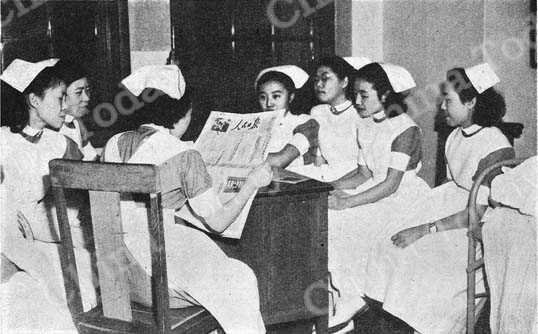
The number of nurses in China is increasing. No less than 85,000 middle-grade medical workers, including nurses, are to be trained in the next five years.
Subsequently, when the County Health Department sent its own teams to carry out inoculations for typhoid, they found the ground already prepared. Again with Miss Mi's active help, they inoculated 5,222 people. In the course of one year, Miss Mi, who teaches music, composed 34 songs on health topics. The songs exposed harmful local superstitions, described the symptoms and dangers of various common diseases in easily remembered terms, pointed out the evils of old-style midwifery and so on.
In all China in 1950, the number of persons vaccinated for smallpox reached the unprecedented figure of 57,325,417. Typhoid and cholera inoculations exceeded 13 million. These results would never have been achieved without the energy and devotion of thousands of leaders like Dr. Ko and Miss Mi.
Saving the Newborn
No one can count the hundreds of millions of babies and mothers who perished in old China due to the insanitary practices of the traditional-style midwife. Now these women are retraining themselves and becoming fighters for public health instead of a danger to it.
Midwife Wang Chi-ying of Lin-hsien, Pingyuan province, is a tall, thin woman of 43 who still has bound feet. She is the daughter, granddaughter and great-granddaughter of midwives and has practised her profession for two decades. Up to a couple of years ago she regularly lost more than half her deliveries from "convulsions" (tetanus). This proportion was regarded as "inevitable."
When the local People's Government began a course to re-train old midwives, Wang Chi-ying joined with hesitation. But soon she became one of the best students and asked regularly in the classes: "Why did no one tell us these things before." A kind and conscientious woman, she often exclaimed with deep feeling: "How many children have died from my ignorance!"
Since she completed the course, Wang Chi-ying has delivered 43 babies, including seven difficult cases, without losing a single one. She has taught the new way personally to three other old mid-wives in her village and organized a Midwives' Association covering several villages. Many midwives, stimulated by her example, have gone to training schools. She is recognized as a local health leader, inspects the work of other mid-wives and is called as a consultant in difficult deliveries. Wang Chi-ying is now attending a night school for adults, to learn to read and write.
In 1950, alone, more than 46,371 old-style midwives throughout the country were re-educated with special emphasis on sterilization and asepsis, of which many of them had never heard before. As a result, sample figures from many counties already show a half to two-thirds decrease of infant deaths from tetanus. Every one of the 1,491 rural County Health Departments already fully established in China is charged with re-training these women, on whom the majority of Chinese mothers must necessarily depend until huge numbers of new personnel are graduated.
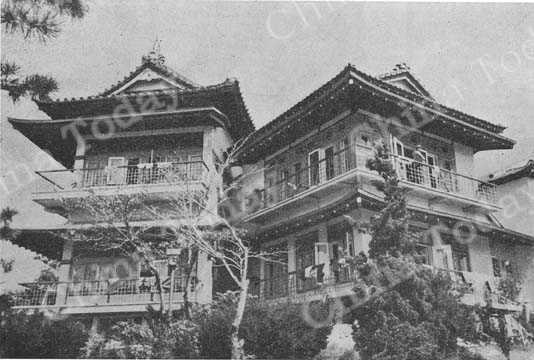
This workers' sanatorium close to the sea in Dairen is an example of how the best buildings are now being used for the health of the people.
Medical Education
The effort being put into training new personnel may be gathered from one figure. Graduates from medical schools in the year 1950 exceeded by six times the highest number in any year under the reactionary Kuomintang regime.
In 1951, the chief emphasis was on the training of middle-grade medical and public health workers, a classification that did not exist in old China at all. Twenty institutions to train such personnel have already been set up. A number of special schools where old-style Chinese doctors can receive supplementary training have also been started in different parts of the country. Many research centres now study the value of the traditional Chinese drugs.
All health and medical personnel, old and new, have been imbued with the spirit of serving the people. The result of their selfless efforts may now be seen in China's rapidly improving public health. The emphasis on preventive medicine, born of the government's concern for the people is already producing results. The absence of epidemics formerly considered "normal" helps to increase both agricultural and industrial production, and improve standards of living.
Medical workers are responsible citizens and are therefore promiment in every nationwide effort and campaign. They are volunteering in thousands to take part in the movement to resist U.S. imperialist aggression and to aid Korea, at present a major feature of our national life. Surgical, medical and epidemic prevention teams from different areas of China are now working on the Korean front where medical teams of the Chinese Red Cross are also active among both troops and people.
Achievements in 1951
In the meantime, the programme for 1951 has been carried out. Not all the figures are as yet available, but those announced for the first ten months of the year are most impressive
Two hundred million people were vaccinated against smallpox as compared to 57 million in 1950.
By November 1951, health departments had been established in 1,865 counties - 85 per cent of all the counties in China.
Several national conferences had been held on various aspects of public health and medicine to undertake further planning and organization.
China's medical workers are confident that, with the aid of the mobilized people and the leadership of the People's Government, our new China will be healthy as well as happy and free.


 Copy Reference
Copy Reference 